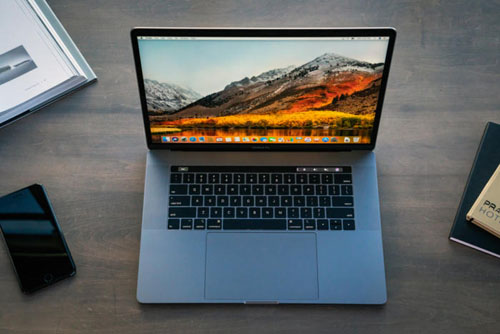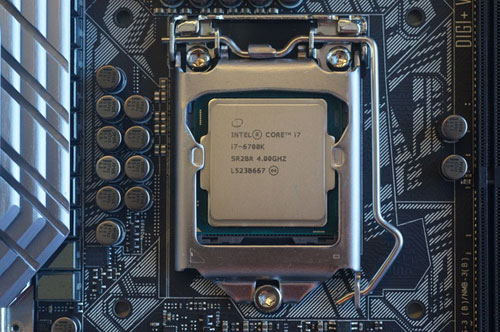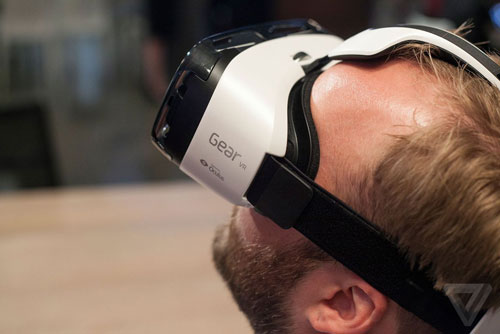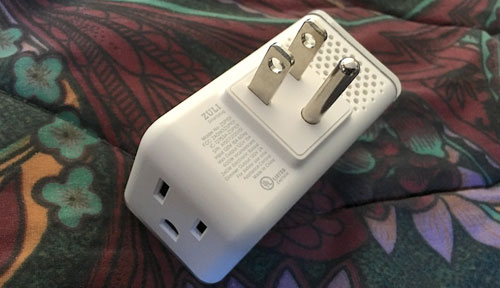Love MacBook Pros but loathe Apple’s rather astronomical retail prices? Today’s your lucky day. Head over to B&H Photo and you’ll find that the retailer is slashing hundreds of dollars off the prices of various models of the 2017 MacBook Pro. In the most extreme case, you can knock off as much as $900.
As you might expect, the price drops aren’t quite so extreme for the entry-level models, but they’re still impressive. Consider these two 13-inch MacBook Pros, which you can pick up for $200 off the listed price.
- 13-inch 2.3GHz/16GB/256GB: $1,649 (down from $1,849)
- 13-inch 3.1GHz/16GB/256GB: $1,799 (down from $1,999)
Want a bigger screen and more power? You’ll be happy to know you can also pick up some comparatively affordable MacBook Pros for impressive discounts. Here are a couple of our favorites.
- 15-inch 2.8GHz/16GB/256GB: $1,899 (down from $2,499)
- 15-inch 2.9GHz/16TB/512GB: $2,149 (down from $2,799)
The biggest price drops, though, affect the models with 1TB or more or storage. That’s a lot of room, and frankly I don’t think many of us need it. But $600 to $900 off is a great deal if you do a lot of work in video, play a lot of games, or simply use your MacBook Pro for everything.
- 13-inch 3.5GHz/16GB/1TB: $2,299 (down from $2,899)
- 15-inch 3.1GHz/16GB/2TB: $3,299 (down from $4,199)
Source: www.macworld.com
Yes, you can overclock cheap Intel Skylake chips
December 19th, 2015 | Edited by Zoran Stosic | hardware
Dec
19
Budget PC builders are in for a treat: It’s been officially confirmed that you can now heavily overclock Intel’s cheap Skylake chips with a BIOS update.
Tech site TechSpot confirmed it through hands-on tests. The team overclocked a Skylake Core i3-6100 from its default clockspeed of 3.7GHz to 4.7GHz, after motherboard maker Asrock provided them with a beta BIOS that required switching off the integrated graphics.
Why this matters: Intel’s last few generation of chips have limited overclocking to pricier “K”-series CPUs. With an apparent workaround discovered, higher clock speeds and essentially “free performance” may become far more attainable for those who can’t afford a K chip.
An overview of overclocking
“Overclocking” is the term for running a CPU’s clockspeed above its rating from the factory. This may sound dangerous—and it can be if done improperly—but many CPUs are artificially limited to lower speeds by Intel at the factory to help meet prices.
Here’s a car analogy: It’s like if Ford sold a top-end Mustang that could hit 150 miles per hour, but then took the same car and set its computer to limit the top speed to 120mph. In this case, Intel’s cheapest “K” Skylake chip is the $242 Core i5-6600K with a factory clock speed of 3.5GHz. The same chip has an equivalent Core i5-6500 for $192 at 3.2GHz. If you could take that cheaper CPU and overclock it to the same speed, why buy the pricier part?
An architecture change within the sixth-generation chip that separates the chip’s “BCLK” (“base clock”) from other components appears to be the culprit behind the newly enabled overclocking. The base clock is one of the internal clocks that regulates the overall megahertz of the chip. With Haswell or Ivy Bridge, for example, the base clock was hooked up to other sections of the CPU, causing instability when the base clock was increased even in small amounts. That’s no longer the case, and after months of speculation over whether or not base clock overclocking could work, we now know it could.
Maybe only dual-cores?
Something to note: TechSpot’s overclocking confirmation was achieved only with the dual-core Core i3 chip. Anandtech’s attempt at performing a base clock overclock of a quad-core Core i5-6500 hit a wall well before TechSpot’s dual-core would. But it isn’t known whether that’s because of the motherboard Anandtech used or because board vendors are still tweaking their BIOSes to enable the overclocking.
Skylake is overclocking-friendly
PCWorld reached out to officials at Intel for comment, but we’ve had no response as of Friday afternoon. However, since the launch of Skylake, Intel has maintained that design changes would make the new chip overclocking-friendly. What’s not clear is whether Intel intended to make the non-premium K-chips overclockable, too.
As mainstream desktop PC sales continue to decline, Intel has increasingly relied on sales to enthusiasts and gamers, who have no problem paying a premium for overclocking-friendly chips. If a groundswell of PC builders suddenly reached for the cheaper, overclock-ready chips to save a few bucks, that could impact sales of Intel’s premium K-chips.
This wouldn’t be the first time Intel had to squash such a trend. Intel’s chipset for its Haswell series included the Z-series for overclockers alongside the cheaper H- and B-series chipsets. When motherboard vendors discovered a way to enable overclocking on the lower-cost H- and B-series, Intel stopped them by updating the microcode on its CPUs, forcing buyers to move back to the higher-margin motherboards with the Z-series chipset.
It’s just as likely that Intel could look the other way. The company has truly been friendlier to overclocking. It has sponsored extreme overclocking contests using liquid nitrogen and liquid helium, and even threw a bone to budget builders with its $72 Pentium G3258 “anniversary edition” in 2014 that was ready for overclocking.
Source: www.pcworld.com
Samsung’s newest Gear VR is now up for preorder
November 14th, 2015 | Edited by Zoran Stosic | hardware
Nov
14
For $100, you can secure the company’s latest take on a virtual reality headset.
Samsung’s improved, cheaper mobile VR headset is ready for the taking. Well, the ordering, anyway.
You can pre-order the new Gear VR directly from Best Buy for $99.99. Unlike the developer-oriented unit that Samsung let out into the wild last year, the new hardware works with the Galaxy S6, S6 Edge, S6 Edge+, and Note 5.
Samsung hasn’t indicated if it will work with future smartphones, as we’ll certainly see another round of Galaxy devices at some point in 2016. However, Samsung has promised a lot of content, such as a 16GB microSD card with “3D movie trailers and 360-degree videos.” Other support includes Netflix, Twitch, Vimeo, and Hulu streaming.
The Samsung Gear VR has a release date of November 20.
Why this matters: With such a low entry-point on price, the Gear VR is a pretty solid way to get your first taste of virtual reality. Of course, the budget price of the headset is offset by the $600+ phone you need to use it with. Of course if you want to go even cheaper, there’s Google Cardboard, which is compatible with practically any modern smartphone. There’s a lot of momentum around this technology. For example, YouTube recently announced you can reconfigure any video for VR.
Source: www.pcworld.com
You can buy Apple’s iPad Pro, Apple Pencil, and Smart Keyboard on Nov. 11
November 10th, 2015 | Edited by Zoran Stosic | hardware
Nov
10
The 12.9-inch tablet and its accessories are available online first, then hit store shelves later this week.
Apple took the wraps off its long-rumored super-sized tablet, the 12.9-inch iPad Pro, back in September, but would only say its release would happen sometime in November. The company announced today that the Pro will go on sale this Wednesday online only, but will arrive in stores “later this week” (usually Apple code for Friday).
The Pro starts at $799 for a 32GB Wi-Fi model and goes all the way up to $1079 for a 128GB version with Wi-Fi and cellular connectivity. The tablet comes in silver, gold, and space gray. The tablet will be available in 40 countries at launch, including the U.S., U.K., Canada, China, France, Germany, Italy, Japan, Mexico, and Russia.
The $99 Apple Pencil, $169 Smart Keyboard, $79 silicone cases, and $59 Smart Covers also go on sale on Wednesday and will appear on store shelves on Friday, if you want to add a few accessories to turn the Pro into a creative multitasking machine.
“The early response to iPad Pro from app developers and our customers has been incredible, and we’re excited to get iPad Pro into the hands of customers around the world this week,” Apple marketing chief Phil Schiller said in a press statement on Monday.
Apple’s press announcement pointed to apps like Adobe’s Creative Cloud suite, including Photoshop Fix, FiftyThree’s Paper, Savage Interactive’s Procreate 3, and sketching tool UMake as examples of the kinds of creative apps that make perfect sense on the iPad Pro.
Why this matters: Apple is releasing the giant Pro as iPad sales are sliding andMicrosoft’s Surface lineup of workhorse tablets is seeing some success. Creatives have long clamored for multitasking features like the ones built into iOS 9, which was designed with the 12.9-inch Pro in mind. You can now run apps side-by-side on smaller iPads, like the iPad Air 2 and iPad mini 4, but those apps will have much more room on the Pro.
We went hands-on with the iPad Pro, Apple Pencil, and Smart Keyboard back in September, but stay tuned for our full reviews of the Pro and its accessories later this week. Are you buying an iPad Pro? Tell us why or why not in the comments.
Source: www.pcworld.com
Zuli Smartplug: A new presence in the home automation market
October 15th, 2015 | Edited by Zoran Stosic | hardware
Oct
15
In this Apple World review, we’re going to be taking a look at a new home automation product called the Zuli Smartplug. This product started out as a very successful Kickstarter campaign with over $175,000 in backing and is now available for sale at the Zuli website and at Lowe’s home improvement stores.
Zuli Smartplugs are available for $59.99 each or $159.99 for what is referred to as a “Presence Pack” of three. I’ll talk a bit more about Presence in a minute and what it means, but to start off with, the Smartplug is similar to those we’ve seen popping up for years. You plug it into a standard US outlet, pair it with an iOS app, and then you can turn it on and off with a tap or with rules that you set up.
Presence is the thing that sets Zuli Smartplugs apart from the rest. If a house has three or more Zuli Smartplugs, they can be used to discern whether or not you’re actually in a room. Your presence in a room can set off a device, so walking into a bedroom, for example, may turn on a lamp and a fan.
The iOS app is one of the best I’ve seen so far for a home automation product, and setup was the easiest and fastest I’ve run through. The Zuli app logically sets up places like home, office, vacation home, and so on, then rooms are defined in those places, and finally Smartplugs are defined in each room. There is a large choice of icons for the type of electrical product the Smartplug is connected to, and you can even make a suggestion for an icon. Rooms can be defined by color, helpful if you have rooms painted in different colors.
Once devices are attached, they can be monitored various ways. First is an energy pane that shows energy usage, estimated monthly cost, estimated active time, and the carbon footprint of the device. The next pane tells you whether or not presence detection is enabled, and it’s possible to set up rules for what happens when you walk into or out of a room. Rooms are calibrated through a simple process, and can be recalibrated at any time. Next, there’s a scheduling screen for setting up schedules. Once again, the Zuli team has done a bang-up job of making the schedule setup process easy and fast. Finally, settings let you name an electrical device, assign an icon to it, define the type of device it is, and see info about the Zuli Smartplug that’s being used.
I recently had a chance to talk with Taylor Umphreys, the founder and CEO of Zuli, about the Smartplug and what he sees on the horizon for the device. The company has a working relationship with the folks at Nest, adding home and away accuracy to the smart thermostat by adding the Presence capability. Presence can tell the Nest Thermostat that someone is in the house, even if they don’t walk by the thermostat. According to Umphreys, you’ll eventually be able to identify individuals in the home and adjust the thermostat accordingly.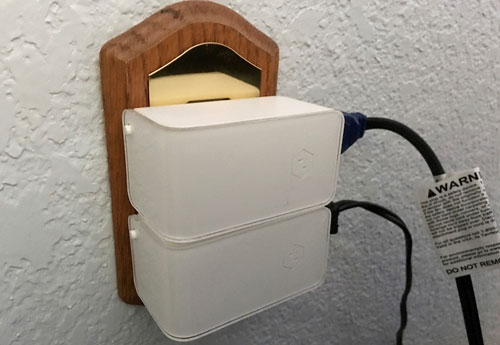
The cooperation with Nest also has a side benefit. Someone who has the Zuli app and decides to purchase a Nest Thermostat will find that they can actually set up the thermostat without using the Nest app. Nest and Zuli have worked together on an interactive end cap display in Lowe’s stores showing how the two devices work together. The company is negotiating other partnerships in the home automation space.
I also asked Umphreys about Presence and how it works. It uses Bluetooth and a special algorithm developed by the company to triangulate the location of a user in relation to the switches. The device uses machine learning algorithms to constantly improve the accuracy of locating users, something I noticed during a month of testing.
At this time, Zuli Smartplugs are not compatible with HomeKit, so don’t plan on using Siri to turn your lights appliancesson or off. Umphreys did say that the company is working on it for an integration in the future; the initial Kickstarter project was run about the time that the HomeKit standard was being developed, so it was impossible to work it into the design.
Being an Apple Watch owner, I was also wondering if Zuli will add a Watch companion app. Umphreys mentioned that it’s on his development team’s radar, but there is no set timeline for a Watch app yet.
Conclusion
Based on the experiences I had setting up the Zuli Smartplugs, using the app, and watching how the devices became more accurate in knowing when I was entering or leaving a room, I was very impressed with the way it works. The Nest Thermostat integration is a huge plus, and the product itself is smartly designed. The only thing keeping me from giving the product a full five-star rating at this time is the lack of HomeKit support.
